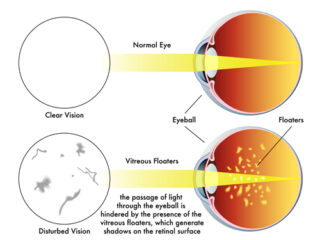
NewView Laser Eye, Inc.
12110 Sunset Hills Road
Suite 50
Reston, VA 20190
NewView Laser Eye, Inc.
20 Davis Ave SW
Leesburg, VA 20175

More Vision & Eye Care Articles
Eye Floaters: Treatment Of Vitreous Strands and Opacities

What are Floaters?
Small specks or clouds moving in your field of vision as you look at a blank wall or a clear blue sky are known as floaters. Most people have some floaters normally but do not notice them until they become numerous or more prominent.
In most cases, floaters are part of the natural aging process. Floaters look like cobwebs, squiggly lines or floating bugs, and appear to be in front of the eye, but are actually floating inside. As we get older, the vitreous (the clear gel-like substance that fills the inside of the eye) tends to shrink slightly and detach from the retina, forming clumps within the eye. What you see are the shadows these clumps cast on the retina, the light-sensitive nerve layer lining the back of the eye.
Treatment of Floaters
Also known as floater laser treatment or laser floater removal, laser vitreolysis is a non-invasive, pain free procedure that can eliminate the visual disturbance caused by floaters. The goal of vitreolysis is to achieve a “functional improvement”. That is, to allow you to return to “normal” day-to-day activities without the hindrance of floaters.
Virtually every individual has experienced or will experience the visual shadows caused by floaters during their lifetime. For most, this event is a minor and short-lived inconvenience, but for a select few, it can become a disabling condition. Clinical studies have shown laser vitreolysis to be a highly effective and safe treatment in the majority of patients with symptomatic floaters.
Vitreolysis involves the application of nanosecond pulses of laser light to evaporate the vitreous opacities and to sever the vitreous strands. During the process, the floater’s collagen and hyaluronin molecules are converted into a gas. The end result is that the floater is removed and/or reduced to a size that no longer impedes vision.
Who can benefit from Vitreolysis?
It is necessary to undergo an ophthalmic examination to determine your eligibility for vitreolysis treatment.
- Age: In most cases, younger patients (<45) suffer from microscopic floaters located close to the retina and are not considered to be good candidates for vitreolysis treatment.
- Onset of Symptoms: If your floater symptoms develop quickly then they may have been associated with PVD, which can be treated with vitreolysis.
- Floater Characteristics: Large floaters with a soft boarder, situated away from the retina, are ideally suited to treatment with vitreolysis.
Complications and Side Effects
Reported side effects and complications associated with vitreolysis are rare. Side effects may include cataract and intraocular pressure (IOP) spike.
Other Articles You May Find of Interest...
- Dry Eye Relief Is In Sight With Optilight
- iDesign Advanced WaveScan Studio
- Norcross Vision Innovators: Glaucoma and Cataract Solutions
- Exploring the Benefits Of Intense Pulsed Light (IPL) For Ocular Surface Health
- Lose Years Off Your Face In Just One Hour
- How to Find a Great Online Shop Offering Same Day Glasses Shipping: Your Quick Guide
- March Is Workplace Eye Wellness Month

















